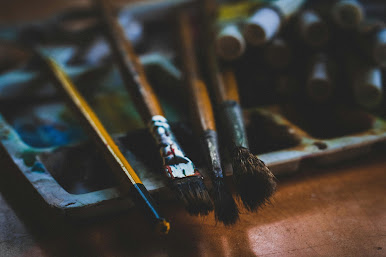Welcome to Brushstrokes & Blooms!
Hello, fellow art enthusiasts! Whether you're a seasoned artist or just picking up a brush for the first time, this blog is your sanctuary for all things watercolor. Join me as we explore the beautiful, fluid world of watercolor painting, where every stroke is a dance of color and creativity.
Why Watercolor?
Watercolor painting is a versatile and expressive medium. Here are a few reasons why it's my favorite:
- Transparency and Light: Watercolors uniquely capture light, creating a luminous and ethereal quality.
- Portability: All you need is a palette, brushes, paper, and water, making it easy to paint anywhere.
- Versatility: From delicate washes to bold, vibrant strokes, watercolors offer endless possibilities.
Getting Started: Essential Supplies
Before diving into techniques and projects, let's start with the basics: the tools you'll need to begin your watercolor journey.
1. Watercolor Paints
There are two main types of watercolor paints:
- Pan Paints: Compact and great for travel. Colors come in small pans that are reactivated with water.
- Tube Paints: Offer more pigment and are better for mixing large washes. They can be squeezed out and diluted as needed.
2. Brushes
Invest in a few good-quality brushes. Here are the essentials:
- Round Brushes: Versatile and perfect for both detail work and washes.
- Flat Brushes: Great for broad strokes, washes, and edges.
- Detail Brushes: For fine lines and intricate details.
3. Paper
Watercolor paper comes in different weights and textures:
- Cold-Pressed (Not): Slightly textured, great for beginners.
- Hot-Pressed (HP): Smooth surface, ideal for detailed work.
- Rough: Heavily textured, perfect for expressive, textured paintings.
4. Palette
A palette is used for mixing colors. It can be a traditional watercolor palette or a simple ceramic plate.
5. Other Essentials
- Water Containers: One for clean water and one for rinsing brushes.
- Paper Towels or a Cloth: For blotting and cleaning.
- Masking Tape or Fluid: To preserve white areas on your paper.
Basic Techniques: The Building Blocks
Apply water to the paper before adding pigment. The paint spreads and blends beautifully, creating soft edges and gradients.
2. Wet-on-Dry
Apply paint directly to dry paper. This technique is great for sharp lines and details.
3. Gradients and Washes
Create smooth transitions of color by gradually adding more water or pigment. Washes are useful for backgrounds and large areas of color.
4. Lifting
Remove paint from the paper using a damp brush, sponge, or paper towel to create highlights and correct mistakes.
Exploring Colors: Mixing and Harmony
Understanding color theory is essential in watercolor painting. Here are some tips for creating harmonious and vibrant artworks:
1. Primary Colors
Red, yellow, and blue are the primary colors. Mixing them in various combinations will give you a full range of hues.
2. Complementary Colors
Colors opposite each other on the color wheel, such as blue and orange, create striking contrasts and can be used to make each other stand out.
3. Analogous Colors
Colors next to each other on the color wheel, like blue, green, and yellow, create harmonious and serene combinations.
Projects for Beginners: Dive In!
1. Simple Landscapes
Start with simple landscapes like skies, mountains, and fields. Focus on gradients and blending.
2. Florals and Botanicals
Flowers and leaves are perfect subjects for practicing wet-on-wet and wet-on-dry techniques.
3. Abstracts and Patterns
Experiment with shapes, colors, and textures. Abstract painting allows for freedom and creativity without the pressure of realism.
Advanced Techniques: Taking It Further
1. Layering and Glazing
Build depth and dimension by layering multiple washes. Allow each layer to dry before adding the next.
2. Negative Painting
Paint around the subject rather than the subject itself. This technique helps in creating interesting shapes and highlighting negative space.
3. Textures and Special Effects
Use salt, alcohol, and other materials to create unique textures and effects in your paintings.






0 Comments